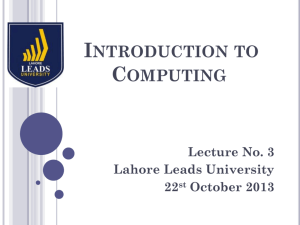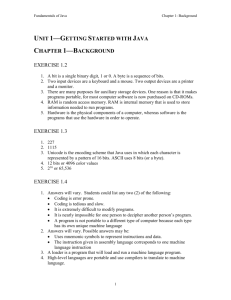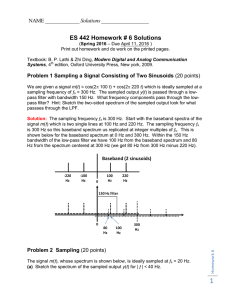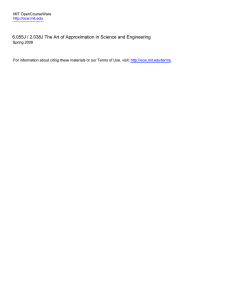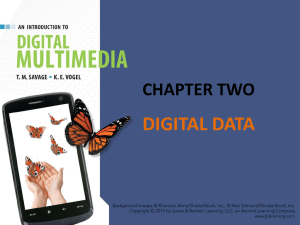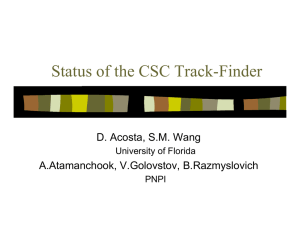Review for Optional Final Exam
advertisement
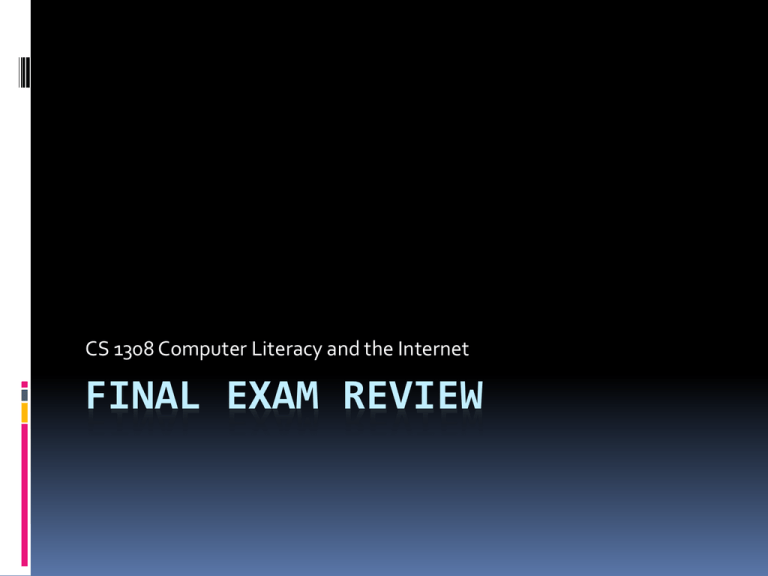
CS 1308 Computer Literacy and the Internet FINAL EXAM REVIEW Exam Format Approximately 120 Total Points 70 Points Multiple Choice 25 Points True or False 10 Points Short Answer 16 Points Matching Similar to lab homework and previous exams Note: These values are approximations. Example Short Answer Why is it important to digitize information? Example Short Answer If you have a network connection that can transmit at 300 Mbps, about how long would it take to download a file that is 2 GB? Example T/F problem T F A Wii controller would be considered an input device. Example Multiple Choice How many bits are in a byte? A) 4 B) 8 C) 10 D) 16 E) 256 What is a Computer? 25 Points All information is digital The more bits you have, the more different things you can represent Know the difference between a “bit” and a “byte” 2bits is a formula for determining the number of things you can represent Von Neumann Architecture Data and instructions stored in memory Should be able to draw it (with labels) Memory RAM What is a Computer (cont.) Input/Output Secondary storage What are input and output devices. Be able to give examples. Central Processing Processor Fetch-decode-execute cycle Instruction sets, machine language (what are they?) Only the sections of chapters covered in class Networks 35 Points Analog vs. Digital What is a modem? Bandwidth Given a speed, calculate transmit time Basic Terminology Ethernet vs.Token Ring LAN, WAN, packet, router, client-server The internet TCP IP Protocols HTTP, FTP Chapter 15 (cont.) Internet Applications What is the difference between a LAN and a WAN? Broadcast vs. packet forwarding What is the difference between the WWW and the Internet? World Wide Web Terminology HTML HTTP Browser Chapter 15 (cont.) E-mail SMTP POP3 FTP Encryption Know how public key encryption works for sending secure messages Building the CPU 3 Points Boolean logic (AND, OR, NOT) Gates, circuits, truth tables Truth tables Know what they are Putting it All Together 15 Points All information is digital The more bits you have, the more different things you can represent 2bits is a formula for determining the number of things you can represent Von Neumann Architecture Data and instructions stored in memory and logically the same Should be able to draw it (with labels) Memory RAM Store and Fetch Cache Putting it All Together (cont.) Input/Output Secondary storage Much slower than RAM What are input and output devices. Be able to give examples. Central Processing Unit Control Unit and Arithmetic/Logic Unit Instruction sets, machine language (what are they?) Fetch-decode-execute cycle Program Counter (PC)/Instruction Pointer (IP)/Accumulator (ACC) Registers Why might more RAM make your computer run faster? Building Software 5 Points Phases of development Requirements gathering Writing Specifications Writing the Code Testing Maintenance and Support The longest of the phases High-level Language Closer to English Compiler Converts a high level language program to machine language for a particular computer. System Software and File Systems 15 Points Operating systems Basic Input/Output (BIOS) What are the main functions of the OS? What resources does the OS manage? Know some of the names of the main Operating Systems (Windows, Mac, Unix, Linux) File Systems File Types Text vs. Binary File protection Files need to be world readable to be shared on the web Directory Trees Absolute vs. Relative Paths Current directory “.” Parent Directory “..” Digital Audio 6 Points What is sound? Analog vs Digital representation of sound What is sampling? Sampling rate (44.1 kHz) Sampling depth (bits per sample, e.g. 16 for CD quality) File size of sampled file MPEG Compression What is it? What factors influence compression? Be able to estimate the size of a file based on the sampling rate and bit depth. Digital Images 6 Points What is a pixel? Digital representation of images Resolution Colors How many bits per pixel? 24 bit true color Sampling depth (bits per sample, e.g. 16 for CD quality) RGB color values Digital Television HDTV What levels of resolution are considered HD? What are the different kinds of technology used to project HD? Information Systems 20 points Spreadsheets Cells Values Formulas =A1+B1….common form of a formula IF, SUM, AVERAGE Concepts from homework assignment Databases Relational Databases Information stored in Tables Keys Relationships Every field should have just one piece of data and no data should be duplicated Structured Query Language (SQL) used to add, modify, delete database content Social Issues 0 points Privacy Encryption Know how public key encryption works for sending secure messages Dangers of Large Databases DMCA What is the advantage of digital over analog versions of information? Are there any disadvantages? Homework Assignments 15 points You will NOT have to do a circuit diagram or truth table. Do each assignment and understand what you did. Remember something about the assignment details. For example, “I imported a plain text file into Google Docs.” Remember what tools you used for what task. You will not have to know the details of what key or menu item to use for a specific task. Do each assignment and understand what you did. Remember something about the assignment details. For example, “I had to figure out the mileage by car and by foot to my elementary school.” Remember what tools you used for what task. You will not have to know the details of what key or menu item to use for a specific task. How to Study Look at old exams. Do the lab assignments (especially the Spreadsheet assignment). Know the vocabulary and acronyms, what they stand for and what they mean. SLEEP!!! What to bring Pencils and erasers We will provide scratch paper You can use a calculator, but leave the cell phones in the bag! Hint: Take the exam backwards. Many times questions from the back of an exam will help with questions at the beginning.





